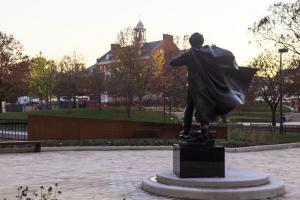The Frederick Douglass Statue Could Be Tied To Social Change At Umd
November 29, 2015

How the Frederick Douglass statue may represent university strides in promoting social justice.
By Anna Muckerman, The Diamondback
If Frederick Douglass were to come to life, to suddenly soften from cold bronze, step off the pedestal in the center of his square and spend an afternoon wandering the sidewalks of our campus, what would he say? Would the abolitionist, author and former slave applaud our university’s commitment to diversity and inclusion? Or would he be surprised that we haven’t made more progress in the 120 years since he died?
As racial conflicts remain ever-present at universities around the country, ours has seen several changes this semester meant to highlight the contributions of African-Americans in our community. The Board of Regents voted to rename the Art-Sociology Building after the university’s first black graduate student, Parren Mitchell. University President Wallace Loh formed a work group with the sole purpose of advising him whether to change the name of Byrd Stadium and lessen the stain of Harry Clifton “Curley” Byrd’s history of racism. And earlier this month, a statue of Douglass was installed on Hornbake Plaza, in a square named after the man whose likeness will permanently occupy it. The statue, five years in the making and shipped from Ireland, is the project of professor Ira Berlin and the university's "North Star" committee.
The university announced the completion of the project with pride, and rightly so. Few would argue that one of the greatest advocates for social justice doesn’t deserve enduring recognition at the flagship university of his home state.
Read more here.

